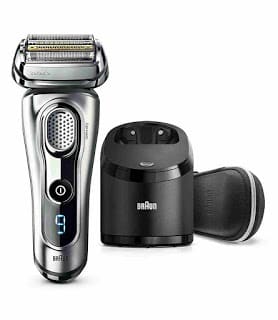Male Shaving
The average beard grows about two-tenths of an inch a day. However, the density of male facial hair varies a great deal depending on skin and hair color, In all races, the concentration is usually greatest on the chin and in the area between. The nose and upper lip.
There is no proof that an electric razor is safer or better for all types of skin than a safety razor. Both types result in nicks and cuts of the living skin tissue, depending on the closeness of the shave.
Twice as many men prefer wet shaving to dry because the use of soap and hot water softens the hair stubble and makes it easier to remove. Shaving authorities point out that thorough soaking is one of the essentials of easy and safe shaving with an electric razor, Leaving the shaving lather on the face for at least two minutes will also soften whiskers a good deal.
How to shave OILY SKIN and DRY SKIN with the electric razor:
Men with oily skin should use an aerosol shaving preparation or a lather type applied with a brush. These are real soaps and are more effective in eliminating the oils that coal the facial hair, thus making it easier to shave with the electric razor.
The electric razor should be moistened with hot water throughout the process, and the chin and upper lip left for last so that the heavier hair centration in these areas has the longest contact with moisture and lather.
DRY SKIN :
A brushless cream is advisable for dry skin since it lubricates the skin rather than further depriving it of oil.
INGROWN HAIRS :
One of the chief problems connected with shaving is that it often causes ingrown hairs, which can lead to pore-clogging and infection. Hair is more likely to turn back into the skin if it is shaved against the grain, or if the cutting edge of the blade is dull and rough rather than smooth.
Men with coarse, wiry, curly hair may find that whisker ends are more likely to become ingrown than men with fine hair. The problem is best handled
by shaving with the grain, using a close sharp blade, and avoiding too close a shave, particularly in the area around the neck.
Use of Electric razor that is less irritating and does not cause skin problem
While the use of a shaving stick with a moist razor is also good, it is extremely important to outline the best electric razor. It is important you choose a high-quality product for good shape.
We all want a fast, clean shave, but unfortunately, many people put their focus on the look of the electric razor instead of its true performance. That’s why reviews team focused on finding what delivered the best shave as well as features like the digital display and adjustable heat settings. After consulting dermatologists and of course, testing the top contenders, reviews team ultimately compiled their findings and some tips they have learned along the way.
The Best Electric Razor
1. Braun Series 9 9290cc
Best for Daily Shaving
2. Philips Norelco Shaver 9300
Best for Weekly Shaving
3. Remington F5 Power Series with Intercept Shaving Technology F5-5800B
Best Budget Shave
SHAVING AND SKIN PROBLEMS :
For men with acne or a tendency to skin problem the following advice is offered by Dr. Howard T. Behrman, director of Dermatological Research, New York Medical College :
- Shave as seldom as possible, perhaps only once or twice a week, and always with the grain.
- If wet shaving is preferred, use a new blade each time, and shave as lightly as possible to avoid nicking pimples.
- Wash face carefully with plenty of soap and hot water to make the beard easy to manage, and after shaving, rinse with hot water followed by cold.
- Use an antiseptic astringent face lotion.
- Instead of plucking out ingrown hairs, loosen them gently so that the ends do not grow back into the skin.
- Although some people. with skin problems find an electric shaver less irritating, in most cases, a wet shave seems best.
The content is intended to augment, not replace, information provided by your clinician. It is not intended nor implied to be a substitute for professional medical advice. Reading this information does not create or replace a doctor-patient relationship or consultation. If required, please contact your doctor or other health care provider to assist you in interpreting any of this information, or in applying the information to your individual needs.




